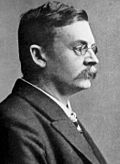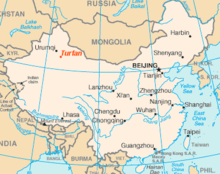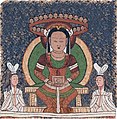German Turfan Expeditions
The German Turfan Expeditions were four expeditions to Turfan and surrounding areas from 1902 to 1914 took place and by the then director of the then director of the Indian Department of the Museum of Ethnology in Berlin, Albert Grünwedel , initiated and together with the Turcologists Albert von Le Coq organized . Both brought thousands of remains of paintings and other art objects, as well as a total of more than 40,000 text fragments to Berlin.
course
The first research team went to Turfan in 1902 and returned a year later with 46 boxes full of treasures. Kaiser Wilhelm II was enthusiastic and financed the second expedition; the third was financed with help from the Ministry of Culture.
Le Coq also found a fresco by the founder of the religion Mani from the 9th century, which shows him with his disciples. He chiseled the picture off the wall and had it brought to Germany. It was destroyed in World War II. Today most of the excavation objects are either in Berlin ( Museum of Indian Art in Berlin-Dahlem) or Delhi . Many exhibits are to be shown in the Humboldt Forum .
- 1st expedition: November 1902 - March 1903 (leader: Grünwedel)
- 2nd expedition: November 1904 - August 1905 (leader: Le Coq)
- 3rd expedition: joined forces with 2nd expedition December 1905 - April 1907 (leader: Grünwedel)
- 4th expedition: December 1913 - January 1914 (leader: Le Coq)
The museum employee Theodor Bartus , who was responsible for removing wall paintings, accompanied all four expeditions. Stations of the various German Turfan expeditions were (in old spelling), among other places Andijan , Kashgar , Maralbashi , Tumschuk , Ak-su , Kyzyl , Kumtura , Kucha , sim-sim , Kirish , Schortschuk , Karashahr , Toksun , Turfan , Khocho , Murtuk , Sängim , Toyok , Komul , Urumchi and Kuldscha .
The whereabouts of the exhibits
The exhibits came to the Museum für Völkerkunde, originally founded in 1873 (today: Ethnological Museum ) and established the new collection on Central Asia. During the Second World War there was a loss of inventory through air raids and evacuation as looted art . In 1956/1957 the collections were brought together in Dahlem and presented first in an independent “Indian Art Department”, later in the “Museum of Indian Art”. From the end of 2020, many exhibits will be on view in the new permanent exhibition in the Humboldt Forum in Berlin-Mitte .
Where to find the text
Some text fragments came into the exhibition, the bulk of the tied parcel was handed over to the then " Royal Prussian Academy of Sciences " for processing. The "Oriental Commission" founded in 1912 took over the coordination. The fragments were unpacked, placed between glass plates and sealed with special black tape. During the 2nd World War the Turfan fragments were moved to Wintershall, Solvayhall and Schönbeck / Elbe. After the war, most of the fragments were handed over to the " German Academy of Sciences ", which was newly founded in 1946 ; smaller parts came to the "Mainz Academy of Sciences and Literature", to the Oriental Seminar of the University of Hamburg and to Göttingen. After the " State Library of Prussian Cultural Heritage " was founded, some fragments came here. In 1992 the fragments were reunited at the "Berlin-Brandenburg Academy of Sciences (BBAW)" Berlin-Brandenburg Academy of Sciences .
- The Berlin turf collection was researched in the Institute for Orient Research, founded in 1947 at the German Academy of Sciences, in particular in the turf research group founded in 1965 by Wolfgang Steinitz and Georg Hazai
- From 1969 to 1991 the Berlin Turfan texts were researched by the "Central Institute for Ancient History and Archeology of the Academy of Sciences in the GDR ".
- Most of the Sanskrit fragments were processed in Göttingen by the "Cataloging of Oriental Manuscripts in Germany" (KOHD) project founded in 1957 by the "Deutsche Morgenländische Gesellschaft". Another project is the "Sanskrit dictionary of Buddhist texts from the Turfan finds and the canonical literature of the Sarvāstivāda school".
- The work of the academy project "Turfanforschung" of the Berlin-Brandenburg Academy of Sciences (BBAW) has concentrated since 1992 on the edition of the Iranian and Old Turkish fragments.
In 2002, on the occasion of the 100th anniversary of the first German Turfan expeditions, an international conference was held in Berlin entitled "Turfan Revisited. The First Century of Research into the Arts and Cultures of the Silk Road".
Example exhibits
“Palm Sunday”, murals from a Christian temple, Chotscho
Manichean temple flags "MIK III 6286" and "MIK III 6283"
See also
literature
- Albert Grünwedel: Old Buddhist cult sites in Chinese Turkistan, report on archaeological work from 1906 to 1907 near Kucha, Qaraæahr and in the Turfan oasis . Berlin, 1912.
- Choros Zaturpanskij (i.e. A. v. Le Coq ): Routes and results of the German Turfan expeditions , Orientalisches Archiv 3, 1912, pp. 116-127.
- Albert v. Le Coq: In Hella's footsteps in East Turkistan. Reports and treatises of the II. And III. German Turfan Expedition . Leipzig, 1926.
- HG Franz: Art and Culture along the Silk Road . Graz, 1986.
- M. Yaldız : Archeology and Art History of China-Central Asia (Xinjiang) . Leiden, 1987.
- H. Härtel / M. Yaldız : The Silk Road: Paintings and sculptures from Buddhist cave temples. From the collection of the Museum of Indian Art Berlin. Berlin: Reimer, 1987.
- Cordula Gumbrecht: Acta Turfanica: The German Turfan Expeditions seen in the archives of Urumchi and Berlin . Berlin, 2002.
Web links
- The German Turfan Expeditions (IDP)
- Silkroad Foundation: Turkan
- Exhibits of the Museum of Indian Art (engl.)



















